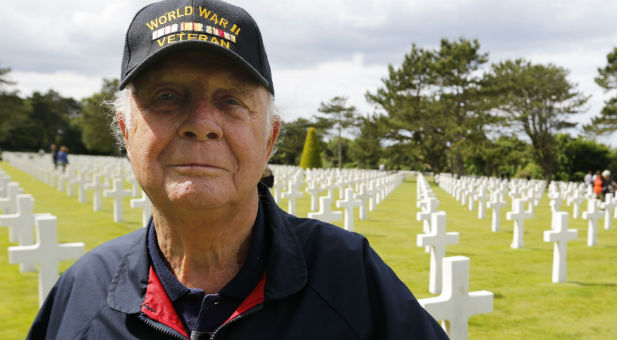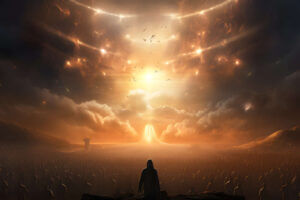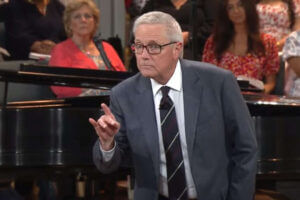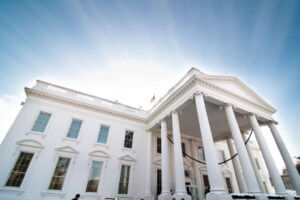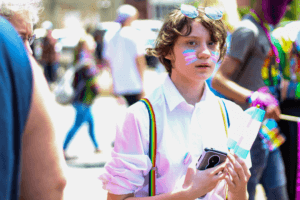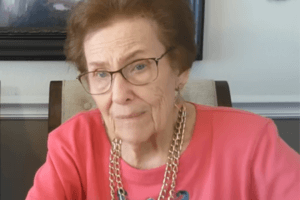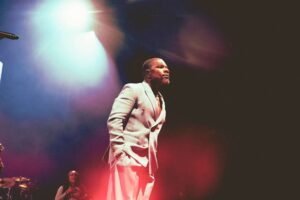Editor’s note: This is part 3 in a multi-part series. Read part 1 here and part 2 here.
Walking through the D-Day cemetery in Normandy, France at Colleville-sur-Mer is an unforgettable and solemn experience, a sacred honor and privilege for all Americans. It was overcast and had rained the day before. The weather was almost identical to that fateful day 55 years earlier. Walking on the grass between the graves, I gently touched the top of a couple of the white marble crosses, then a few more, running my fingers gently over them, stroking the smooth polished marble as I walked slowly along in an unconscious attempt to know. To touch someone. To say “Thank you.”
General Eisenhower recalled at the 20th D-Day Anniversary visit, “These men came here to storm these beaches for one purpose only, not to gain any thing for ourselves, not to fulfill any ambitions America had for conquest, but just to preserve freedom, systems of self-government in the world.”
France had granted the United States a special, perpetual concession for eternity to the land occupied by the American cemetery. The 172 acres were given to the United States. They are U.S. soil enacted by French law in appreciation for the liberation of France from Nazi tyranny.
It was the 55th Anniversary of the D-Day Remembrance Ceremonies in 1999, and I had been invited by the State Department as a guest but also had the duty of organizing logistics for some groups and senior responsibility for organizing the official D-Day Remembrance church service at the American Protestant Church in Bonn, Germany, in conjunction with the National Cathedral in Washington, D.C.
I was following the official U.S. Department of Defense historians and their State Department counterparts and other D-Day veterans, VIPs, men from the 101st Screaming Eagles, the 82nd Airborne and others who had landed on Omaha and Utah beaches that day as they shared their stories among themselves of walking along the landing, making it to the sand dunes, cutting the barbed wire, taking out the entrenched German machine gun nests and securing their sectors of the beaches. Then they spoke of fighting their way to D-Day +1, D-Day +3 and D-Day +5 objectives. It was an incredible and moving experience to be in the company of such great and humble men. They have been called the “Greatest Generation,” and no other generation has ever come close.
The Defense Department historians then turned the conversation pointing to the beautiful wooded area left natural to the south on the hill overlooking the 10,000 white crosses. The Defense Department historians and the American Battle Monuments Commission experts explained how the American Protestant Church was shaped like a cross as part of their original intent to build it there in the woods as the Stimson Memorial Chapel for the World War II D-Day veterans to pray and for church ceremonies to take place on every special occasion.
The shape of the building, its humble New England architecture and small size was chosen for the lot in the trees because it reflected the humility and character of the men who served. The Defense Department historians explained how the D-Day veterans did not want to build a grand cathedral of marble, granite and gold dedicated to themselves. No way. The concept, they said, was immediately rejected and voted down. The church they chose to have was to be a simple, humble, church with the layout in the shape of a cross that was to be consecrated and dedicated as a lasting memory to the men who served and died that day.
But, because the Allied High Commission government had already been formed to govern Germany in the new capital of Bonn, and because the U.S. Army chaplains there had already established a sizeable congregation composed of U.S. servicemen, two churches were needed, one in Colleville-sur-Mer and one in Bonn. But after the war with reconstruction underway across Europe, there wasn’t enough money for two churches.
Therefore, it was decided to build the church in Bonn.
The Defense Department, in conjunction with the State Department officials, decided that they would hold the “political D-Day ceremonies” for the U.S. president, the president of France, the British and Canadian prime ministers at the American cemetery at Colleville-sur-Mer every 10 years and then have the combined religious ceremony the following Sunday, always in Bonn in a joint service with the U.S. National Cathedral in Washington, D.C.
The APC was the epicenter of D-Day Remembrance Ceremony gatherings and trips for Americans, their families, government employees and corporations in Europe. The church service was always packed out with all windows open and seating set up outside on the grass and on the patio outside the front of the church with an accompanying U.S. military color guard beginning the ceremonies. Father Steve represented the Catholics and would later return to lead another Catholic congregation this time in Bedford, Virginia, home of the U.S. D-Day Memorial where more young men perished on D-Day from Bedford than any other town in the U.S.
The church was built in 1951. Its chapel was named after Henry L. Stimson, U.S. secretary of war, by U.S. High Commissioner John J. McCloy and was consecrated and dedicated to the D-Day veterans and all who served in World War II, in Bonn on July 18, 1952.
What everyone should know is, that without ever attending the D-Day Remembrance ceremonies at Colleville-sur-Mer, France, anyone’s knowledge of the American Protestant Church is vastly incomplete at best. No one could understand what the APC is about, what it is dedicated to do and its role and duty in Europe if you haven’t been to the D-Day Remembrance ceremonies at Colleville-sur-Mer, France, or the service at the U.S. National Cathedral in Washington.
But there is far more to the church story than that.
100 Percent All-American
When the D-Day church structure, its architecture and design were approved, everything—all of the materials, the lumber, the two-by-fours, the plywood, windows, the bricks, cement, the sand for the cement, all pipes, roofing shingles, nails, flooring, paint, paint brushes, tarps, door knobs, hinges, any and all equipment and so on—were sourced in Virginia from around the Naval Air Station Norfolk and naval harbor. It was all packed in containers and shipped to Bonn from Virginia Beach, Virginia, aboard U.S. Navy Liberty ships, a class of military cargo vessels designed and built during World War II.
Two other buildings and their plans were included in the containers on the trip. Two homes directly across the road from the APC were built in the same manner. One for the representative U.S. general and another for the U.S. State Department Charge d’Affairs’ home. Both remain there (newly renovated) until this day.
What many people don’t know is, because it was going to be the D-Day church and Stimson Memorial Chapel, all of the labor, all of the men who built the APC were U.S. Army engineers or U.S. citizens. It was built with only 100 percent American labor. Even as they dug the hole for the basement, even the sand that was spread on the ground separating the dirt from the building was sent from Virginia Beach. The only local supply was water taken from the Rhine that was pumped up 150 meters and used to mix the cement and paints.
Eternally American
The purpose was to send an eternal message to friends and enemies alike, that this is an American church, an American chapel dedicated to the men who fell at D-Day and other U.S. veterans of World War II. Reinforcing the point that they are eternally the honored guests and members, who now can pray in an American church on American soil built by American labor, consecrated to the gospel and to those who fell. The American Protestant Church was now to represent all of the American Protestant denominations and Catholics as well, and also became the home to the first Jewish synagogue in Bonn in post-war Germany.
The APC pulpit is the home of all of the American pastors and priests and ministries. The pulpit was considered the well, the door, the spring of blessing from all of America’s ministries to the military servicemen, to Germany, Europe and beyond.
The Most Expensive Church in the World
As the men were talking, walking through the cemetery they discussed the cost of men, lives, treasure and gold that was made to liberate Europe. And in the continuing conversation, the true cost of building the American Protestant Church in Bonn was mentioned.
Which begs the question: What is the most expensive church to be built in the history of Christianity? Is it the Dom in Cologne, Germany with its twin spires that took over 1,000 years to build? Or is it St. Paul’s Cathedral in London? With its marble and rich artistic history? Or maybe St. Peter’s Basilica in Rome, the home of the Catholic Church? No.
The consensus among the servicemen while spoken and unspoken as they walked along was unanimous. It was the humble, New England church shaped like a cross now situated in Bonn.
The true cost to build the APC was the 10,000 white crosses in Colville-sur-Mer, over 14,000 crosses at Henri-Chapel, The Netherlands; another 8,000 crosses at the cemetery in Arnhem; and over 400,000 more at U.S. military cemeteries in Europe and around the world, with another 26 million more lives paid for by the Allies.
The total lives lost in World War II by the Americans and their Allies to defeat Nazi Germany; the ships, planes and tanks that needed to be built; the guns and armaments in the Ardennes, Italy, North Africa and the Pacific make the Virginia brick and wooden American Protestant Church the most expensive church ever to be built. Why? Because no other country in the history of the world has ever had to pay a higher price to put up a church than the United States has had to do in order to build the American Protestant Church in Bonn, having to defeat Nazi Germany first.
It is an honor and privilege to worship in the APC, not a right. To the American World War II veterans, it is sacred and hallowed ground.
English Roots
But the story of the American Protestant Church doesn’t end or even begin there. You must open the pages of early American history, Act One, Scene One to understand more of its significance.
On April 29, 1607, the first permanent settlement was established when English settlers first landed in Virginia at what is presently named Cape Henry (named after King James I of England’s first son) at the mouth of the Chesapeake Bay by planting a large wooden cross in the sand under the guidance of Rev. Robert Hunt. After arriving in the New World, and after dedicating and consecrating themselves in prayer and repentance for three days, they got out of the ship, came ashore and knelt, planting the cross and dedicating all of Virginia’s natural resources, its timber, soil, gold, silver, iron, resources and land in its charter, dedicating it for the purpose of the proclamation of the gospel of Jesus Christ.
After the prayer of dedication and covenanting together, the Reverend Hunt declared, “From these very shores, the gospel shall go forth not only to this New World but the entire world.” The first American Protestant Church services began there under an old sail until a building could be erected.
The Rev. Hunt ended with “All the ends of the world shall remember and turn to the Lord, and all the kindreds of the nations shall worship before thee. For the kingdom is the Lord’s and he ruleth among the nations” (Ps. 22:27-28, KJV).
The wording of the original charter, the first state charter and other documents can be found at Regent University, Law School, Virginia Beach, Virginia; the state capitol building; and other institutions and libraries.
The very sand, clay and timber and materials from Virginia Beach and Cape Henry where Reverend Hunt had dedicated all of Virginia and its resources in 1607 before the large wooded cross to be used for proclamation of the gospel are the very bricks, sand, mortar, cement, plywood, timbers and roof of the American Protestant Church in Bonn. It all came from Virginia. The blue Kempsville Lumber Yard stamp on the two-by-fours can be seen inside the building.
Rev. Hunt’s prayers kneeling in the sand at Cape Henry was an unalterable covenant that God the Father would not forget even unto this day.
“For the Lord thy God is a merciful God, he will not forsake thee, neither destroy thee, nor forget the covenant of thy fathers which he swore unto thee” (Deut. 4:31, KJV).
That was: Act One Scene One of the unfolding drama of America that had begun on the shores of Cape Henry with Rev. Hunt kneeling in the sand, forward 300 years later to the construction of the only church the U.S. government has ever built that proclaims the gospel to Europe and the world.
Eisenhower closed with these words in his visit to Normandy, “I devoutly hope that we will never again have to see such scenes as these. I think and hope, and pray that humanity has learned more that we have learned up until that time (D-Day). But, these people (those who died in the graves) gave us a chance. They bought time for us so we can do better than we have before. So every time I come back to these beaches, or of any day that I think about that day 20 years ago, I say once more we must find some way to work to peace to gain an eternal peace for this world.”
President Reagan stated in his address at the 50th D-Day Anniversary, “We will always remember. We will always be proud. We will always be prepared so we may be always free.”
However, the Germans, their international supporters and the weak APC church leadership, despite arguments, objections and protests, stopped the D-Day Remembrance ceremonies in the APC before the 60th anniversary for the Americans and any assistance given and any church service.
As the Germans said, “It’s a war.”
The war isn’t over … yet.
Full victory. Nothing else.
*** Your voice counts! If you would like to express your opinion about the treatment of WWII veterans or Americans in their own church, please feel free to express your opinions to the positions listed here from the APC Internet site or call: +49.228.374.193; Fax: +49 (228) 374 723
Email: [email protected], [email protected], [email protected], [email protected], [email protected], [email protected], [email protected], [email protected], [email protected], [email protected]
Steven V. Selthoffer is an American communications executive living in Bonn, Germany. He works as a sport investigative journalist exposing corruption in Olympic sports. Selthoffer swam for U.S. Olympic coach Dr. James E. Counsilman, Indiana University. He has worked for Deutsche Telekom and T-Mobile on a number of large projects.
His father was friends with President Kennedy and Robert Kennedy and grew up playing touch football with Kennedy family members. JFK, Robert and Ted Kennedy came to the Selthoffer’s home in Bethesda, MD on a number of occasions for lunches and friendly family and neighborhood gatherings. President Kennedy who was aboard PT-109 in the Pacific and Joseph R. Selthoffer who served on board the U.S.S. Nevada (BB-36) often spoke together about their times aboard ship and in various campaigns.
Steven V. Selthoffer also has a background in relief aid, security and international relations. He has testified before the OSCE, a joint session of the U.S. House and Senate of Congress on international relations and security. He has also worked in cooperation with the U.S. State Department and other agencies on relief aid and various other issues.
See an error in this article?
To contact us or to submit an article



